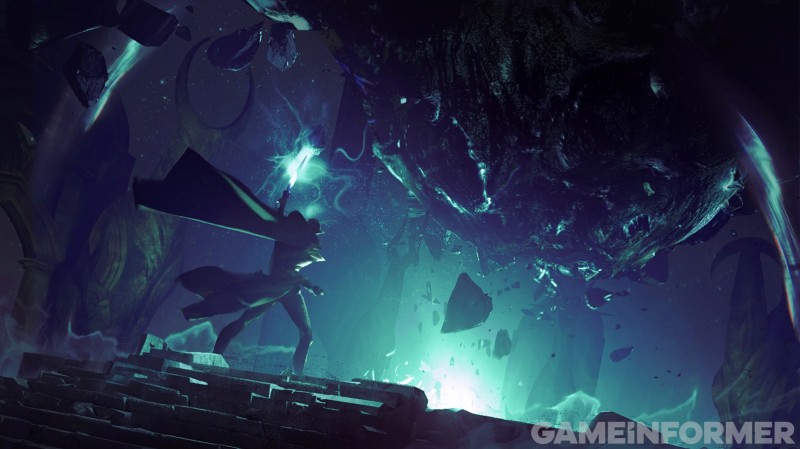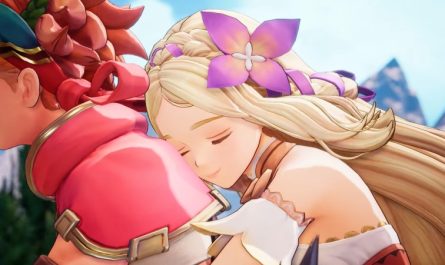Dragon Age 4 was revealed years ago under the name Dragon Age: Dreadwolf. However, with seemingly months to go before the game’s fall 2024 launch, BioWare announced it was changing the name to Dragon Age: The Veilguard. Ahead of that announcement, Game Informer visited BioWare’s Edmonton office for an exclusive look at the game for our Dragon Age: The Veilguard cover story. It’s here we learned that the name had changed.
I interviewed various Veilguard leads for the cover story, and one of the first questions I asked each of them was, “Why the name change?” Here’s what each told me:
BioWare’s Leads On Changing The Name To Dragon Age: The Veilguard
Veilguard game director Corinne Busche: “First of all, I would say that these games are reflections of the teams that make them, and as part of that, it means we learn a lot about what the heart and soul of the game really is as we’re developing it. And we quickly learned and realized that the absolute beating heart of this game are these authentic diverse companions. When we took a step back, as we always do, we always check our decisions and make sure that they still represent the game we’re trying to build. It just felt like we needed a title that represented what this game was truly about.
Now, I want to be clear: I adore Solas [and] he plays an important role in the game, but this is not a game about Solas. So in all things we do, trying to capture that authentic experience, we felt the title really needed to change.”
Veilguard creative director John Epler: “Dragon Age has always been about characters, not just the villains, but also your team, your companions, the other characters in the world. And as we were building Dragon Age: The Veilguard – there’s this analogy I like to use, which is, ‘If you want to carve an elephant out of marble, you just take a piece of marble and remove everything that doesn’t look like an elephant.’ As we were building this game, it became really clear that it was less that we were trying to make The Veilguard and more like The Veilguard was taking shape as we built the game.
Solas is still a central figure in it. He’s still a significant character. But really, the focus shifts to the team. It’s about the people you recruit. It’s about stopping the end of the world with this group of specialists, these incredibly interesting and diverse characters that you recruit into your team. [We] realized Dreadwolf suggests a title focused on a specific individual, whereas The Veilguard, much like Inquisition, focuses more on the team.”
BioWare general manager Gary McKay: “First, let me say: Solas is still very much part of this game. This is absolutely nothing to say that he’s taking a back seat. But when we reflected on what was really the heartbeat of this game, we really saw the companions jumping out at us. I think you could argue [these companions] are the best the franchise has ever seen. We have seven incredibly unique characters, each with their own personalities, motivations; they have deep stories, and you have an opportunity to really interact with these characters in a way that both shapes their story but also influences the main story, right down to having an opportunity to impact their fate.
It’s not just the story; they are also integral to the gameplay as well. And so when you look at it from really what the heartbeat of this game is, the centerpiece of the game, it’s about the companions – the Veilguard. We felt that the title needed to reflect what we thought the centerpiece of this game was.”
Former Dragon Age executive producer and Veilguard consultant Mark Darrah: “I think it’s absolutely the right choice. Names can take on a momentum. Arguably, this game has kind of, in a way, been called Dreadwolf to some degree since its earlier days. As the game evolved, as [BioWare] figured out exactly what it was, it’s very mature to step back and say, ‘We called it something. Does it really still reflect what the game is?’ And I think the fact the team was willing to take that step is amazing, and I think this is absolutely the right decision.”
The Solas In The Room
When I ask about Solas’ role in the story after I learn his namesake is no longer in the game title, Darrah says Veilguard is still taking the Elven God’s narrative in a good direction. He adds, “It allows us to, hopefully, give a good conclusion to all the varied attitudes toward Solas that are going to be coming from people who love Solas, who agree with Solas, who hate Solas, people who want to kick Solas off of a building – I think that we give you the opportunity to bring that to a close, but then tell a greater story about The Veilguard and about the world as a whole.”
Talking to Epler, I learn more about how Solas isn’t exactly the big bad I expected before seeing the opening hours of Veilguard. There’s a lot more nuance to everyone’s favorite bald elf.
“The most interesting villains to myself, and honestly most people, are not just straight up, ‘I want to end the world.’ To them, they are the heroes of the story, and Solas is no exception,” Epler tells me. “Solas always feels that he is a tragic hero but a hero nonetheless, so he’s coming into this believing firmly that what he did, that which you stopped him from doing, was the right thing – that you made a mistake. But now he’s trapped and can’t reach out and actively affect [Thedas], so he needs to work with you.
“That allows us to provide a lot of nuance to that relationship,” Epler says.
If you’re wondering what Epler means when he says Solas trapped, it’s quite literal – in the game’s prologue, which is part of the 20-minute gameplay segment BioWare recently released (the above video), the player-character Rook and companions Lace Harding, Varric Tethras, and Neve Gallus stop Solas’ attempt to destroy the Veil, a barrier between the magical Fade and Thedas. I won’t spoil exactly what happens here, but Rook passes out moments later and wakes up in a dream-like landscape to the voice of Solas himself… because he’s trapped here.
He explains he was attempting to move the Elgar’nan and Ghilan’nain, both of whom are part of the Evanuris or Elven gods of ancient times, to a new prison because the old one was no longer containing them properly. Unfortunately for Solas, he’s trapped here – the Fade – by our doing and Elgar’nan and Ghilan’nain are free, blighted, and roaming Thedas. It’s up to Rook to stop them, but it seems they’ll have to work with Solas (or at least listen to his guidance and advice) to do so.
“So one of the principles we took to when we were building the story of The Veilguard early on was we wanted the beginning of the game to feel like the final chapter of an earlier story and you’re coming in right at the end, you’re coming in as if you’ve been chasing Solas – the [Solas at the end of Dragon Age: Inquisition’s Trespasser DLC] who said he was going to end the world and tear down the Veil,” Epler adds.
Epler says players will see early on (and as the narrative develops across Veilguard) that Solas sees much of himself in you, the player-controlled Rook, especially “the parts that maybe he doesn’t like to face.” As a result, there’s an interesting push and pull between Solas and Rook. He says players can define the relationship between these two characters with their choices in dialogue.
“You can continue to be suspicious and hostile towards him, or you can start to see him and find that common ground, that connection between the two of you, and really develop a different relationship over the course of the story,” Epler says.
For more about the game, including exclusive details, interviews, video features, and more, click the Dragon Age: The Veilguard hub button below.
Dragon Age 4 was revealed years ago under the name Dragon Age: Dreadwolf. However, with seemingly months to go before the game’s fall 2024 launch, BioWare announced it was changing the name to Dragon Age: The Veilguard. Ahead of that announcement, Game Informer visited BioWare’s Edmonton office for an exclusive look at the game for our Dragon Age: The Veilguard cover story. It’s here we learned that the name had changed.
I interviewed various Veilguard leads for the cover story, and one of the first questions I asked each of them was, “Why the name change?” Here’s what each told me:
BioWare’s Leads On Changing The Name To Dragon Age: The Veilguard
Veilguard game director Corinne Busche: “First of all, I would say that these games are reflections of the teams that make them, and as part of that, it means we learn a lot about what the heart and soul of the game really is as we’re developing it. And we quickly learned and realized that the absolute beating heart of this game are these authentic diverse companions. When we took a step back, as we always do, we always check our decisions and make sure that they still represent the game we’re trying to build. It just felt like we needed a title that represented what this game was truly about.
Now, I want to be clear: I adore Solas [and] he plays an important role in the game, but this is not a game about Solas. So in all things we do, trying to capture that authentic experience, we felt the title really needed to change.”
Veilguard creative director John Epler: “Dragon Age has always been about characters, not just the villains, but also your team, your companions, the other characters in the world. And as we were building Dragon Age: The Veilguard – there’s this analogy I like to use, which is, ‘If you want to carve an elephant out of marble, you just take a piece of marble and remove everything that doesn’t look like an elephant.’ As we were building this game, it became really clear that it was less that we were trying to make The Veilguard and more like The Veilguard was taking shape as we built the game.
Solas is still a central figure in it. He’s still a significant character. But really, the focus shifts to the team. It’s about the people you recruit. It’s about stopping the end of the world with this group of specialists, these incredibly interesting and diverse characters that you recruit into your team. [We] realized Dreadwolf suggests a title focused on a specific individual, whereas The Veilguard, much like Inquisition, focuses more on the team.”
BioWare general manager Gary McKay: “First, let me say: Solas is still very much part of this game. This is absolutely nothing to say that he’s taking a back seat. But when we reflected on what was really the heartbeat of this game, we really saw the companions jumping out at us. I think you could argue [these companions] are the best the franchise has ever seen. We have seven incredibly unique characters, each with their own personalities, motivations; they have deep stories, and you have an opportunity to really interact with these characters in a way that both shapes their story but also influences the main story, right down to having an opportunity to impact their fate.
It’s not just the story; they are also integral to the gameplay as well. And so when you look at it from really what the heartbeat of this game is, the centerpiece of the game, it’s about the companions – the Veilguard. We felt that the title needed to reflect what we thought the centerpiece of this game was.”
Former Dragon Age executive producer and Veilguard consultant Mark Darrah: “I think it’s absolutely the right choice. Names can take on a momentum. Arguably, this game has kind of, in a way, been called Dreadwolf to some degree since its earlier days. As the game evolved, as [BioWare] figured out exactly what it was, it’s very mature to step back and say, ‘We called it something. Does it really still reflect what the game is?’ And I think the fact the team was willing to take that step is amazing, and I think this is absolutely the right decision.”
The Solas In The Room
When I ask about Solas’ role in the story after I learn his namesake is no longer in the game title, Darrah says Veilguard is still taking the Elven God’s narrative in a good direction. He adds, “It allows us to, hopefully, give a good conclusion to all the varied attitudes toward Solas that are going to be coming from people who love Solas, who agree with Solas, who hate Solas, people who want to kick Solas off of a building – I think that we give you the opportunity to bring that to a close, but then tell a greater story about The Veilguard and about the world as a whole.”
Talking to Epler, I learn more about how Solas isn’t exactly the big bad I expected before seeing the opening hours of Veilguard. There’s a lot more nuance to everyone’s favorite bald elf.
“The most interesting villains to myself, and honestly most people, are not just straight up, ‘I want to end the world.’ To them, they are the heroes of the story, and Solas is no exception,” Epler tells me. “Solas always feels that he is a tragic hero but a hero nonetheless, so he’s coming into this believing firmly that what he did, that which you stopped him from doing, was the right thing – that you made a mistake. But now he’s trapped and can’t reach out and actively affect [Thedas], so he needs to work with you.
“That allows us to provide a lot of nuance to that relationship,” Epler says.
If you’re wondering what Epler means when he says Solas trapped, it’s quite literal – in the game’s prologue, which is part of the 20-minute gameplay segment BioWare recently released (the above video), the player-character Rook and companions Lace Harding, Varric Tethras, and Neve Gallus stop Solas’ attempt to destroy the Veil, a barrier between the magical Fade and Thedas. I won’t spoil exactly what happens here, but Rook passes out moments later and wakes up in a dream-like landscape to the voice of Solas himself… because he’s trapped here.
He explains he was attempting to move the Elgar’nan and Ghilan’nain, both of whom are part of the Evanuris or Elven gods of ancient times, to a new prison because the old one was no longer containing them properly. Unfortunately for Solas, he’s trapped here – the Fade – by our doing and Elgar’nan and Ghilan’nain are free, blighted, and roaming Thedas. It’s up to Rook to stop them, but it seems they’ll have to work with Solas (or at least listen to his guidance and advice) to do so.
“So one of the principles we took to when we were building the story of The Veilguard early on was we wanted the beginning of the game to feel like the final chapter of an earlier story and you’re coming in right at the end, you’re coming in as if you’ve been chasing Solas – the [Solas at the end of Dragon Age: Inquisition’s Trespasser DLC] who said he was going to end the world and tear down the Veil,” Epler adds.
Epler says players will see early on (and as the narrative develops across Veilguard) that Solas sees much of himself in you, the player-controlled Rook, especially “the parts that maybe he doesn’t like to face.” As a result, there’s an interesting push and pull between Solas and Rook. He says players can define the relationship between these two characters with their choices in dialogue.
“You can continue to be suspicious and hostile towards him, or you can start to see him and find that common ground, that connection between the two of you, and really develop a different relationship over the course of the story,” Epler says.
For more about the game, including exclusive details, interviews, video features, and more, click the Dragon Age: The Veilguard hub button below.Read MoreGame Informer



